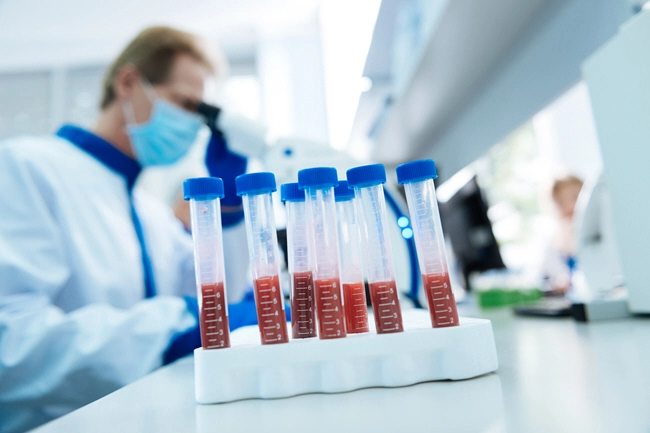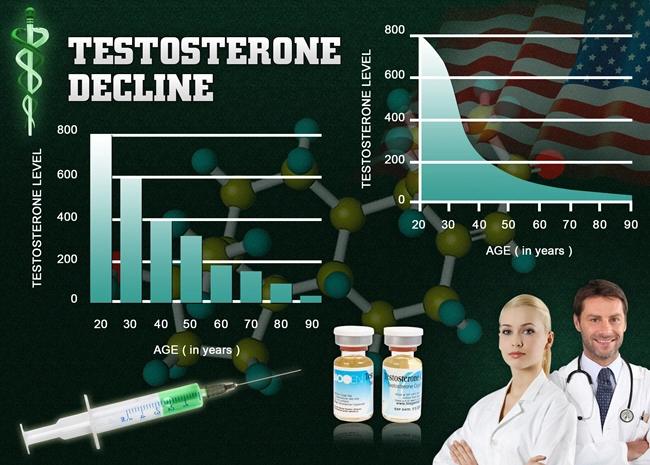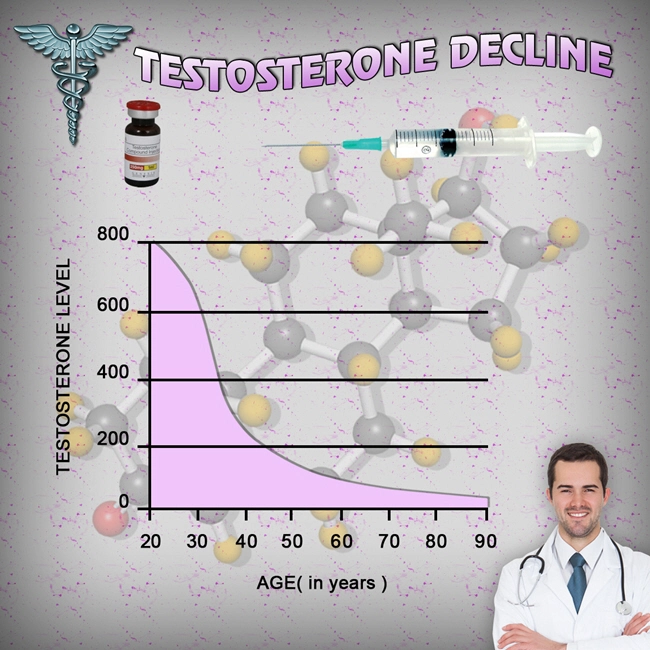
Video Link: https://vimeo.com/286854530
Video Download: Click Here To Download Video
Video Stream: Click Here To Stream Video
Video Link: https://vimeo.com/286854530
Video Download: Click Here To Download Video
Video Stream: Click Here To Stream Video
The Effects of Hypogonadism on Men
Learn more about the causes and cures of this ever-increasing problem
 Your physician enters the room with a somber demeanor and announces “Your blood tests are back, and it's confirmed: you have hypogonadism.”
Your physician enters the room with a somber demeanor and announces “Your blood tests are back, and it's confirmed: you have hypogonadism.”
The response of many men to this somewhat confusing pronouncement is often: “what's that?” The medical, professional, clinical definition of hypogonadism is the reduction or absence of hormone secretion or other physiological activity of the gonads (testes).
The Endocrine Society practice guideline has a similar definition: Hypogonadism in men is a clinical syndrome that results from failure of the testis to produce physiological levels of testosterone (thus androgen deficiency) and a standard number of spermatozoa due to disruption of one or more levels of the hypothalamic-pituitary-testicular axis.
In plain English, this means decreased production of the essential male hormones that make men MEN...especially testosterone and dehydroepiandrosterone (DHEA). This condition is sometimes given the moniker "low t."
Then more depressing news follows. All-too-often, older men are told that their status is accurately called Age-Associated Hypogonadism, sometimes referred to as Late-onset hypogonadism.
At around age 31, a man's levels of growth hormone and testosterone begin to decline at a rate of approximately 10% per decade, depending on many health factors like family history, genetics and lifestyle behaviors. This is usually due to a combination of impaired testicle function and lower hormonal input from the brain.
Since this condition creeps into a man's life slowly the effects, however severe, appear gradually and may go undetected for extended periods. Therefore, they are attributed to healthy aging, and they may be told that there are no treatments that can reverse this condition.
Men are told to make lifestyle changes: lose weight, exercise, improve your diet, sleep more, control stress, etc. These are all great suggestions. But at best they can only slow down the loss of testosterone, and the debilitating conditions resulting from low testosterone (“Low-T”) levels.
But You Won't Hear That From our HRT Clinic

There are an estimated 4 to 5 million men in the United States that are suffering from hypogonadism, and as a man's age increases so does the frequency of this affliction. Recent surveys have concluded that over 60% of men aged 65 and older experience a drop in average testosterone levels.
Sadly, as mentioned above, this condition is often not diagnosed or treated, with approximately a mere 5% of hypogonadal men undergoing testosterone replacement therapy.
But at our clinic, things are different. We take a holistic approach to the problem. We begin with an accurate diagnosis. Various afflictions cause your Low-T symptoms, and we will determine precisely what your condition is. Then we'll swing into action, and directly attack the reasons for these symptoms. There is no reason for you to continue suffering because...
These Debilitating Symptoms are Anything but Fun
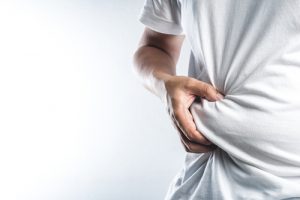 Here are a few of the results of age-associated hypogonadism:
Here are a few of the results of age-associated hypogonadism:
- Shrinking muscles and maddening loss of strength
- Constant, chronic fatigue
- Increasing difficulty maintaining balance
- Accumulating slabs of ugly, disease-producing fat
- Weakened bones, since bones lose their mineral density when testosterone levels plummet. This makes them especially vulnerable to fracture in the event of a fall...which may occur as a direct consequence of the conditions listed above
- Diminished or complete loss of libido and decreased spontaneous erections
- Ever-increasing nagging joint aches and pains
- The stiffness of the body, with increasing loss of flexibility
- Loss of appetite, which makes all of the above afflictions worse
- Brain fog, characterized by an inability to concentrate and experiencing memory difficulties
- Insomnia, with trouble with both falling asleep and staying asleep

- Hypertension
- Kidney problems
- The onset of the feared and hideous metabolic syndrome. This condition is in several different states, none of them good: elevated blood sugar levels, ever-expanding waistline, skyrocketing cholesterol and triglyceride levels, inflated blood pressure -- all of which dramatically increase the risk of severe health problems such as diabetes, stroke, cancer, and heart attack. Something to be avoided at all costs.
- Irritability and depression. The zest for life begins to leave. And why wouldn't it? To investigate the link between depression and hypogonadism, Shore and Associates studied computerized medical records from a regional Veterans Administration. The subjects were depressed men comprised of a mixture of Low-T patients and those with normal testosterone levels. The psychiatrists that were treating the depressed men did not know any patient's testosterone levels, so their results were not influenced by any pre-existing conditions. The study consisted of 278 men, and the results showed that depression was higher in men diagnosed with hypogonadism (21.7 percent) than men who did not suffer from hypogonadism (7.1 percent). The conclusion? The link between Low-T and depression is there and has been proven time and time again, beyond a shadow of a doubt.
- Diminished quality of life. All of these symptoms take a terrible toll on a man's ability to function in all primary spheres of existence: physical, emotional, social, sexual, and cognitive.
- Lower life expectancy. Studies have shown that men over age 40 with normal testosterone levels had a mortality rate of 20%, while men with Low-T had a rate of 35%, over a mean follow-up of 4.3 years.
There are Additional Categories of Male Hypogonadism
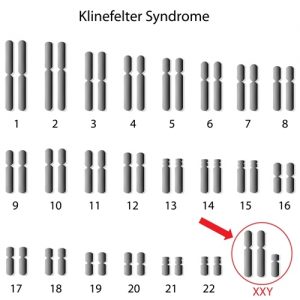 Age-associated hypogonadism is not by itself a complete diagnosis. There are other, similar classifications of hypogonadism. Here is a list of them:
Age-associated hypogonadism is not by itself a complete diagnosis. There are other, similar classifications of hypogonadism. Here is a list of them:
- Primary Hypogonadism. This condition is directly a result of testicular problems. The causes range from Klinefelter syndrome (A genetic situation in which a male is born with an extra copy of the X chromosome, causing the testes to under-develop), Noonan's syndrome (a genetic disorder that prevents normal development in various parts of the body, often resulting in slow growth, short stature, heart defects and other physical ailments), mumps orchitis (testicular inflammation), orchiectomy (surgical removal of one or both testicles), undescended testes, aging, and chemotherapy.
- Secondary Hypogonadism. With this condition, the testicles are healthy, so the cause is usually an imbalanced hormonal system. This can result in Pituitary Pathology, Kallman Syndrome (failure to start and complete puberty), chronic opioid abuse, aging, Prader-Willi syndrome (a genetic disorder that causes obesity, intellectual disability, and shortness in height), and uncontrolled stress.
- Normogonadotropic Hypogonadism. This condition causes low sperm counts, and although levels of Follicle-stimulating Hormone (FSH) and Luteinizing Hormone (LH), are average, there is a small degree of serum T (total testosterone), resulting in fertility problems.
- Hypogonadotropic Hypogonadism. This is a form of hypogonadism that is due to a problem with the pituitary gland or hypothalamus.
There are More Causes of Hypogonadism
 As mentioned earlier, aging is usually the culprit when hypogonadism raises its ugly head. But there is another catalysis as well, such as…
As mentioned earlier, aging is usually the culprit when hypogonadism raises its ugly head. But there is another catalysis as well, such as…
- Severe illness. Diabetes, cancer, severe liver disease and hyperthyroidism are high on the list of medical problems that are linked to hypogonadism.
- Obesity. This is a self-inflicted condition that wreaks havoc on testosterone levels. And it's getting worse. Obesity rates rose an astonishing 90% in merely six short years, from 1988-1994! Simply put: an ever-expanding waistline = lower testosterone circulating in the bloodstream.
- Medications. Sadly, increasing age often comes with a full plate of prescription pills. Some of the side effects of these numerous medications can crater male hormone levels.
- Testicular failure
- Hypothalamic-pituitary axis dysfunction
- Malnutrition, possibly brought on by unhealthy eating habits
- Environmental toxins
There are other possible causes as well. But before we elaborate on the common origins of hypogonadism, a few brief explanations of how testosterone works are in order.
The All-Important Difference Between Free Testosterone (FT) and Bound Testosterone
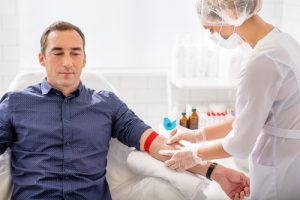 There is a common misconception that a testosterone blood test should measure total testosterone (free and unbound testosterone). But this doesn't tell the whole story...far from it.
There is a common misconception that a testosterone blood test should measure total testosterone (free and unbound testosterone). But this doesn't tell the whole story...far from it.
In healthy men, only a small percentage (1-3%) of total testosterone is free testosterone (“FT”). This is the testosterone that circulates in the blood stream, enters the muscles and cells, and performs its vital functions of keeping men strong and shrinking fat cells.
The vast majority of testosterone is handcuffed to a hormone called the sex hormone-binding globulin (SHBG). As men age, this ratio gets worse -- that is, less FT is available, and more testosterone is bound to SHBG.
The result? Less free testosterone, which creates a perfect environment for the debilitating side effects previously listed.
The thing to remember is this: if you have the symptoms of Low-T, and are considering getting a blood test to check your testosterone levels, make sure that you don't solely rely on your total testosterone level.
The ratio of FT to SHBG is even more critical. If your blood test uncovers a drop below average in your FT level, it may be time to consider your treatment options.
Hypogonadism and Low-T ARE NOT the Same Things
Despite the fact that most, if not all of the symptoms of hypogonadism are identical to the symptoms of Low-T, there is a difference. Andropause (male menopause) is the natural decline of male hormones as a direct consequence of the aging process.
Hypogonadism refers to the body's inability to produce testosterone as a result of an abnormal condition, usually in the testes or brain, but possibly from the causes listed above (i.e., obesity, medications, etc.).
Regardless of which condition you are diagnosed with, the critical thing is that both conditions are treatable. Fortunately, when it comes to TRT…
The Times They Are A-Changin'

To steal a quote from an old Bob Dylan song, the times are indeed a-changin' when it comes to the benefits and availability of testosterone replacement therapy.
Previously, the medical community has been reluctant to treat this condition. And the media has sensationalized any adverse side effects from the treatment, while simultaneously downplaying the benefits of TRT.
The result of this has been a persistent lack of understanding of the benefits of TRT. This makes it difficult for men suffering from the condition to seek and receive treatment.
This is in part caused by the reluctance of physicians to prescribe a testosterone replacement treatment, due to the narrow constraints mandated by the Food and Drug Administration (FDA).
Critics of testosterone replacement therapy often insist that the marketing of the product by pharmaceutical companies has created a demand for a product that is at best unnecessary, and at worst, harmful.
However, the numbers don't support this. In 2012, drug companies spent approximately $1.6 billion in the United States. This pales in comparison to the $19.7 billion dedicated to marketing statin drugs, and the $4.3 billion spent on erectile dysfunction drugs.
Furthermore, when the studies are carefully examined, all-too-often they have a severe flaw: as mentioned earlier, most studies measure the level of total testosterone, rather than free testosterone, also known as bio-available testosterone.
The bottom line? This approach has resulted in far too much needless suffering for men with Low-T. But things are finally changing. Many men undergoing TRT are suffering from age-associated hypogonadism, not primary or secondary hypogonadism.
In the past, many men with age-associated hypogonadism were told they did not meet the standard definition of the disease. This resulted in problems obtaining insurance re-reimbursements and issues with regulatory agencies.
But with the growing awareness of the long-term consequences of Low-T, attitudes are changing….much for the better.
Studies Confirm the Benefits of Testosterone Replacement Therapy
 At a consensus conference held in Prague, the Czech Republic last year, medical experts gave unanimous approval to nine resolutions after a severe academic debate. The decisions concluded that Low-T is a critical medical condition that causes several adverse effects in men; that the problem is a public health concern.
At a consensus conference held in Prague, the Czech Republic last year, medical experts gave unanimous approval to nine resolutions after a severe academic debate. The decisions concluded that Low-T is a critical medical condition that causes several adverse effects in men; that the problem is a public health concern.
Also, that safe, effective treatment is available; that there is no scientific basis for the age-associated recommendations against the use of testosterone and, perhaps most importantly, there is no evidence that TRT (Testosterone Replacement Therapy) raises a man's risk of prostate cancer.
In 2013, a Boston University study concluded that testosterone replacement therapy restores healthy levels of cholesterol and triglycerides and may reduce the risk of cardiovascular disease.
The study also found that TRT lowered fasting blood glucose and hemoglobin A1c, which may improve insulin sensitivity and hyperglycemic control.
Still another study conducted in 2012 at the Bayer Pharma headquarters in Berlin, Germany demonstrated that weight-loss was yet another overlooked benefit of testosterone replacement therapy. The study consisted of 255 Low-T or hypogonadal men with an average age of 61, with a two-year follow-up.
On average, the men lost 36 pounds, and 3.5 inches from their waist. This is fabulous news, since weight-loss drugs, exercise and dietary changes have produced, at best, sporadic successful, long-lasting results. It's a vicious circle.
Many overweight men suffer from hypogonadism, and Low-T causes more weight gain.
One final study needs to be mentioned. A Kaiser Permanente Northwest, Portland Oregon study, conducted in 2011 concluded that men with higher testosterone levels lose less muscle mass as they age. 1,183 men 65 years or older participated in the study.
Their body composition and physical performance were measured over a period of 4.5 years. The results were clear: The level of testosterone men have in their bodies showed a strong correlation to how much muscle mass they retain as they age.
A New Book Addresses the Problem
Dr. Malcolm Carruthers, founder and chief medical consultant of the Centre for Men's Health, has authored a new book entitled: Testosterone Resistance: Fighting for the Men's Health Hormone.”
His premise is simple. Low-T contributes to numerous medical problems, some severe. Many men with Low-T symptoms are confused about their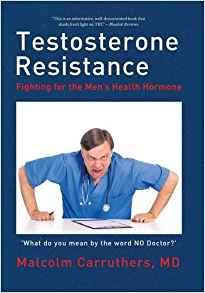 options for treatment and don't understand their condition. As a result, Dr. Carruthers feels they are not receiving the treatment they need.
options for treatment and don't understand their condition. As a result, Dr. Carruthers feels they are not receiving the treatment they need.
“It’s time to overcome the resistance of the medical establishment to the widespread use of testosterone in treatment and preventive medicine,” Carruthers said.
“This is a game-changer -- millions of men worldwide are being denied treatment which could restore them to full health safely, economically, and quickly.”
Carruthers insists testosterone replacement therapy has the potential to be the most efficient form of preventive medicine of the twenty-first century, and both medical professionals and patients need to be aware of the new possibilities for treating symptoms of testosterone deficiency.
What Our Clinic Can Do For You
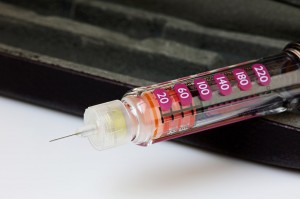
Always remember this: you don't have to continue suffering in silence. At our clinic, we have the most cutting-edge treatments that are designed to coax your body into ramping up testosterone production.
Our toolbox is jam-packed with several options to ensure you will receive the type of therapy that is specially designed for you: testosterone capsules; injections, both short-term (once every two to three weeks) and long-term (once every ten to fourteen weeks).
We also use gels that are directly rubbed into the skin and go to work quickly; patches that are time-released; and implants (small pellets that are speedily and painlessly implanted underneath the skin in the buttocks or lower back).
The pros and cons of each of these approaches will be explained to you in detail, and together we will determine the most effective treatment option.
We don't just stop with testosterone replacement therapy. We will give you specific recommendations on everything from nutrition, stress reduction, exercise, and every other area of your life that can cause your testosterone levels to explode!
We have over a decade of experience in this rapidly-evolving field. There is no reason for you to continue to suffer. Contact us. Contact us today with your questions about Low Testosterone or HGH; Hypogonadism can be treated effectively!
Reference
Evolution of Guidelines for Testosterone Replacement Therapy.
Contact Us Today For A Free Consultation
Dear Patient,
Once you have completing the above contact form, for security purposes and confirmation, please confirm your information by calling us.
Please call now: 1-800-380-5339.
Welcoming You To Our Clinic, Professor Tom Henderson.
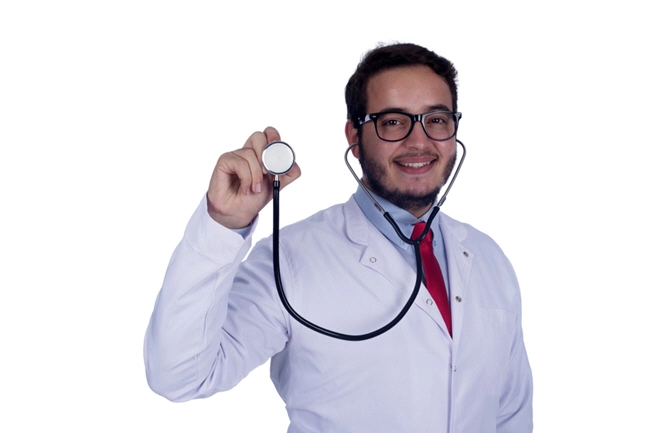
- Are You Constantly Feeling Tired And Fatigued ? [Last Updated On: April 27th, 2025] [Originally Added On: May 1st, 2018]
- Constantly Tired? Can't Sleep? [Last Updated On: March 14th, 2025] [Originally Added On: March 23rd, 2019]
- How to Understand and Deal with Cirrhosis [Last Updated On: March 13th, 2025] [Originally Added On: April 12th, 2019]
- Insomnia: The Silent Killer [Last Updated On: March 12th, 2025] [Originally Added On: April 30th, 2019]
- Lipocine Reintroduces Tlando [Last Updated On: August 19th, 2025] [Originally Added On: March 18th, 2020]
- High-Intensity Interval Training Boosts Both Body and Mind [Last Updated On: February 20th, 2025] [Originally Added On: May 10th, 2020]
- Tattoo Safety: What to Know Before You Get a Tattoo [Last Updated On: February 28th, 2025] [Originally Added On: June 2nd, 2020]
- Testosterone and Fatherhood [Last Updated On: April 25th, 2025] [Originally Added On: October 12th, 2020]
- L-Arginine: The Key to Both Heart Health and Sexual Health [Last Updated On: March 10th, 2025] [Originally Added On: December 4th, 2020]
- The Importance of Hormonal Balance for Menopause [Last Updated On: February 20th, 2025] [Originally Added On: December 14th, 2020]
- Menopause Drugs: Study Stokes New Debate Over Cancer Risks [Last Updated On: March 8th, 2025] [Originally Added On: December 16th, 2020]
- Study Examines Link Between Growth Hormones and Osteoporosis [Last Updated On: March 11th, 2025] [Originally Added On: December 17th, 2020]
- Everything You Need to Know About Clomiphene [Last Updated On: March 9th, 2025] [Originally Added On: December 20th, 2020]
- Fast Facts About DHEA: What You Need to Know About This Natural Steroid [Last Updated On: August 16th, 2025] [Originally Added On: March 4th, 2021]
- Enjoy a Few Drinks Weekly? Beware: This May Be a Link to Low Sperm Counts and Quality [Last Updated On: March 6th, 2025] [Originally Added On: August 16th, 2021]
- Hormone Therapy May Benefit Some Women's Hearts [Last Updated On: February 20th, 2025] [Originally Added On: August 18th, 2021]
- HGH Male Blood Panel [Last Updated On: October 28th, 2021] [Originally Added On: September 28th, 2021]
- Growth Hormone Battles Osteoporosis [Last Updated On: February 26th, 2025] [Originally Added On: October 11th, 2021]
- Growth hormone = More Sleep = Better Sex! [Last Updated On: March 7th, 2025] [Originally Added On: October 11th, 2021]
- The Link Between Testosterone and Tylenol [Last Updated On: February 21st, 2025] [Originally Added On: October 12th, 2021]
- Hormone Replacement Therapy and Aerobics May Ease Menopause Symptoms [Last Updated On: February 19th, 2025] [Originally Added On: October 13th, 2021]
- Growth Hormone and Lifestyle = An Extended Lifespan [Last Updated On: February 23rd, 2025] [Originally Added On: October 13th, 2021]
- Growth Hormone, Foods, and Supplements for Healthy Skin [Last Updated On: May 10th, 2025] [Originally Added On: October 13th, 2021]
- Hormone Replacement Therapy, Menopause, and Cancer [Last Updated On: February 24th, 2025] [Originally Added On: October 13th, 2021]
- Growth Hormone, Exercise, and Osteoporosis: The Facts! [Last Updated On: February 22nd, 2025] [Originally Added On: October 13th, 2021]
- Hormone Replacement Therapy and Menopause [Last Updated On: February 25th, 2025] [Originally Added On: October 13th, 2021]
- Testosterone and Women [Last Updated On: February 18th, 2025] [Originally Added On: October 13th, 2021]
- Growth Hormone and Smoking [Last Updated On: February 19th, 2025] [Originally Added On: October 14th, 2021]
- Testosterone, Statins, and Prostate Cancer [Last Updated On: February 18th, 2025] [Originally Added On: October 19th, 2021]
- Researchers Investigate Declining Sperm Counts, Find Chemicals Rampant [Last Updated On: May 23rd, 2025] [Originally Added On: June 14th, 2022]
- Understanding the Role of Hormonal Balance in Menopause [Last Updated On: February 7th, 2025] [Originally Added On: February 7th, 2025]
- Introduction: Benefits of Hormone Replacement Therapy [Last Updated On: February 8th, 2025] [Originally Added On: February 8th, 2025]
- The Influences and Benefits of High-Intensity Interval Training [Last Updated On: February 8th, 2025] [Originally Added On: February 8th, 2025]
- The Link Between Human Growth Hormone, Exercise, and Osteoporosis [Last Updated On: February 9th, 2025] [Originally Added On: February 9th, 2025]
- The Therapeutic Benefits of Human Growth Hormone [Last Updated On: February 16th, 2025] [Originally Added On: February 16th, 2025]
- Introduction: The Reality of Menopause [Last Updated On: February 18th, 2025] [Originally Added On: February 18th, 2025]
- An Introduction to the Benefits of Human Growth Hormone Replacement Therapy [Last Updated On: February 19th, 2025] [Originally Added On: February 19th, 2025]
- Introduction to Hormone Replacement Therapy [Last Updated On: February 20th, 2025] [Originally Added On: February 20th, 2025]
- Introduction: Evaluating the Safety of Hormone Replacement Therapy [Last Updated On: February 23rd, 2025] [Originally Added On: February 23rd, 2025]
- The Rise of Tattoos in America [Last Updated On: February 23rd, 2025] [Originally Added On: February 23rd, 2025]
- The Influence of Growth Hormone and Sleep on Libido [Last Updated On: February 27th, 2025] [Originally Added On: February 27th, 2025]
- Introduction: The Association Between Alcohol Consumption and Sperm Quality [Last Updated On: February 27th, 2025] [Originally Added On: February 27th, 2025]
